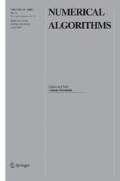Abstract
In this paper we develop a function with a functional form similar to general potential energy functions and whose global minimum is known. We prove that the number of local minimizers of this function increases exponentially with the size of the problem, which characterizes the principal difficulty in minimizing molecular potential energy functions. In order to guarantee the global optimality and to show the difficulty in obtaining the global minimum of this function, we propose the utilization of a deterministic algorithm. The algorithm is based on a branch and bound scheme that uses interval analysis techniques to calculate the lower bounds. Computational results for problems with up to 25 degrees of freedom are presented.
Similar content being viewed by others
References
N.L. Allinger, Y.H. Yuh and J.-H. Lii, Molecular mechanics. The MM3 force field for hydrocarbons, J. Amer. Chem. Soc. 111 (1989) 8551–8582.
H. Barbosa, F. Raupp, C. Lavor, H. Lima and N. Maculan, A hybrid genetic algorithm for finding stable conformations of small molecules, in: Proc. of the VIth Brazilian Symposium on Neural Networks (IEEE Computer Soc. Press, Los Alamitos, 2000) pp. 90–94.
T. Brodmeier and E. Pretsch, Application of genetic algorithms in molecular modeling, J. Comput. Chem. 15 (1994) 588–595.
B.R. Brooks, R.E. Bruccoleri, B.D. Olafson, D.J. States, S. Swaminathan and M. Karplus, CHARMM: A program for macromolecular energy minimization and dynamics calculations, J. Comput. Chem. 4 (1983) 187–217.
C.A. Floudas, J.L. Klepeis and P.M. Pardalos, Global optimization approaches in protein folding and peptide docking, in: DIMACS Series in Discrete Mathematics and Theoretical Computer Science, Vol. 47 (Amer. Math. Soc., Providence, RI, 1999) pp. 141–171.
R.S. Garfinkel and G.L. Nemhauser, Integer Programming (Wiley, New York, 1972).
E.R. Hansen, Global Optimization Using Interval Analysis (Springer, Berlin, 1993).
H. Kawai, T. Kikuchi and Y. Okamoto, A prediction of tertiary structures of peptide by Monte Carlo simulated annealing method, Protein Engrg. 3 (1989) 85–94.
R.B. Kearfott, Rigorous Global Search: Continuous Problems, Nonconvex Optimization and Applications (Kluwer Academic, Dordrecht, 1996).
J. Kostrowicki and H.A. Scheraga, Application of the diffusion equation method for global optimization to oligopeptides, J. Phys. Chem. 96 (1992) 7442–7449.
C.D. Maranas and C.A. Floudas, Global minimum potential energy conformations of small molecules, J. Global Optim. 4 (1994) 135–170.
C.D. Maranas and C.A. Floudas, A deterministic global optimization approach for molecular structure determination, J. Chem. Phys. 100 (1994) 1247–1261.
G.P. McCormick, Nonlinear Programming: Theory, Algorithms and Applications (Wiley, New York, 1983).
L.G. Mitten, Branch and bound method: General formulation and properties, Oper. Res. 18 (1970) 24–34.
R.E. Moore, Interval arithmetic and automatic error analysis in digital computation, Ph.D. dissertation, Stanford University (1962).
M.A. Moret, P.G. Pascutti, P.M. Bisch and K.C. Mundim, Stochastic molecular optimization using generalized simulated annealing, J. Comput. Chem. 19 (1998) 647–657.
A. Neumaier, Interval Methods for Systems of Equations (Cambridge Univ. Press, London, 1990).
G. Némethy, K.D. Gibson, K.A. Palmer, C.N. Yoon, G. Paterlini, A. Zagari, S. Rumsey and H.A. Scheraga, Energy parameters in polypeptides. 10. Improved geometrical parameters and non-bonded interactions for use in the ECEPP/3 algorithm with application to proline-containing peptides, J. Phys. Chem. 96 (1992) 6472–6484.
P.M. Pardalos, D. Shalloway and G.L. Xue, Optimization methods for computing global minima of nonconvex potential energy functions, J. Global Optim. 4 (1994) 117–133.
L. Piela, J. Kostrowicki and H.A. Scheraga, The multiple-minima problem in the conformational analysis of molecules. Deformation of the potential energy hypersurface by the diffusion equation method, J. Phys. Chem. 93 (1989) 3339–3346.
A. Pogorelov, Geometry (Mir Publishers, Moscow, 1987).
J.G. Rokne, Low complexity k-dimensional centered forms, Computing 37 (1986) 247–253.
D. Stevenson, IEEE standard for binary floating point arithmetic, Technical Report, IEEE/ANSI 754–1985, IEEE (1985).
J.M. Troyer and F.E. Cohen, Simplified models for understanding and predicting protein structure, in: Reviews in Computational Chemistry, Vol. II, eds. K.B. Lipkowitz and D.B. Boyd (VCH, New York, 1991) pp. 57–80.
D.J. Wales and H.A. Scheraga, Global optimization of clusters, crystals and biomolecules, Science 285 (1999) 1368–1372.
S.J. Weiner, P.A. Kollmann, D.T. Nguyen and D.A. Case, An all atom force field for simulations of proteins and nucleic acids, J. Comput. Chem. 7 (1986) 230–252.
Author information
Authors and Affiliations
Rights and permissions
About this article
Cite this article
Lavor, C., Maculan, N. A Function to Test Methods Applied to Global Minimization of Potential Energy of Molecules. Numerical Algorithms 35, 287–300 (2004). https://doi.org/10.1023/B:NUMA.0000021763.84725.b9
Issue Date:
DOI: https://doi.org/10.1023/B:NUMA.0000021763.84725.b9



